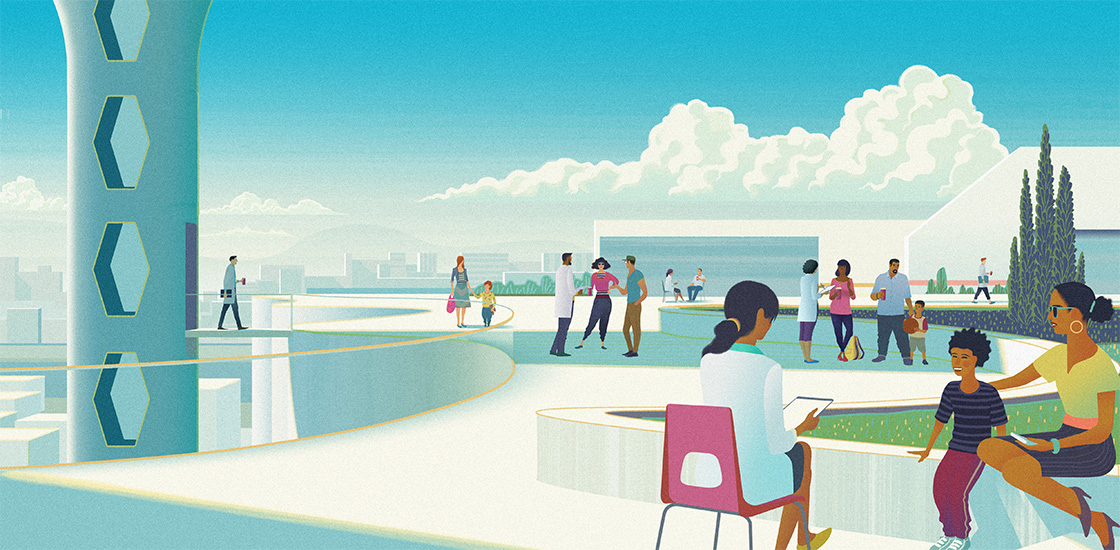Questions for Daniel Geschwind: Making autism studies diverse
A team of researchers is stepping out of the lab and into the community to recruit African-Americans for studies on the genetics of autism.

People from minority groups have traditionally been underrepresented in autism research, and genetic studies are no exception.
For example, African-Americans constituted just over 2 percent of individuals in the Autism Genetic Resource Exchange, a large repository of genetic information, in 2008. African-Americans make up 13 percent of the total U.S. population, according to the 2015 census.
This lack of diversity is a serious shortcoming for the studies. For example, researchers can miss variants that crop up only in certain populations.
Daniel Geschwind’s team at the University of California, Los Angeles (UCLA), along with researchers at three other universities set out in 2013 to increase the number of African-Americans in autism studies. One aim of the project is to see whether patterns of variants tied to autism in people of European descent also augur risk in African-Americans. So far, the answer seems to be no.
We asked Geschwind what strategies his team is using to recruit families, and why the work is important.
Spectrum: How does diversity benefit autism genetics?
Daniel Geschwind: Geneticists benefit from having a relatively homogeneous population for studies that identify genes. This ensures that genetic variation isn’t different between cases — in this case, people with autism — and controls because of variations in ethnicity. This is one reason most genetic studies to date have been in people of European descent.
But rare variants may crop up only in certain populations, so a study that mostly enrolls people of European descent might miss those variants. Alternatively, variants that are rare and seem harmful in people from one genetic background may not be so rare in another population. Increasing the diversity of genetic databases could show that some of those variants aren’t harmful after all.
We are also working to understand how certain combinations of common variants that each have a small effect size can together raise the risk of autism. The field has developed a ‘polygenic risk score’ that is a composite measure of the common genetic risk for autism. But so far, this score is based on genetic information from people of European descent.
We need to ask whether these findings apply to people of different genetic backgrounds. We have preliminary evidence that suggests that they don’t. The polygenic risk we see in European populations with autism doesn’t translate to African-Americans.
S: How are you recruiting African-American families?
DG: Several of our research sites have experience with African-American families based on the sites’ proximity to places where many of these families live. These sites are Washington University in St. Louis, the Marcus Autism Center in Atlanta and Albert Einstein College of Medicine in the Bronx, New York.
Things were a lot more challenging for our group at UCLA. Los Angeles is a huge city with a large African-American community. But given traffic and geography, UCLA is not a convenient place for many people in the African-American community to visit.
A local group called the Special Needs Network offered to help us with outreach in Los Angeles. They gave us advice about how to make the project less daunting for families. For instance, it can take you an hour to drive five miles in this city. People have to take a full day off work to come in for an evaluation. So we decided to work on weekends and take our whole team out into the community, into venues such as schools or churches. We’re trying to meet families halfway to make it easier for them to participate.
S: How does the recruitment process work?
DG: Our community partners help us reach out to families who have at least one child with autism. We see about 8 to 10 of these families per weekend and are trying to see about 40 to 50 families a year at each of our research sites, including here in Los Angeles.
We meet with the families and take blood samples from children with autism, as well as their parents and siblings when possible. We also collect questionnaires from parents that rate autism features, and we interact with the children in order to better understand their social-communication profile.
In addition, we conduct a structured interview that goes through each family’s diagnostic odyssey. It covers when they first had a concern about their child, when they first saw a doctor and everything they had to do to get treatment for their child. Some families who visit will have already received a diagnosis for their child and are interested in participating in research. Others might have multiple kids, some of whom are still undiagnosed.
The Special Needs Network helps by providing babysitting services, so parents don’t have to worry about their children while they work with the researchers.
We cannot actually diagnose children during these events, but we provide face-to-face feedback on their features to their parents to help guide them to the right diagnosis and treatment. We also provide parents with short written reports that they can share with their child’s school.
S: Have you learned anything about autism diagnoses in this population?
DG: This isn’t an epidemiologically representative sample, but we can begin to collect preliminary data to understand how and when children in this population are diagnosed. Our work sets up the key questions that researchers can follow up on in a more representative sample.
So far, we are finding that there are still very significant delays in diagnosis. The delay is not because these parents are not concerned about their children, or ignoring warning signs. And it’s not because they don’t have access to a doctor. In fact, many see a doctor multiple times. Almost one-third of the families had to go to five doctors or more before getting an autism diagnosis.
One might consider several reasons this is happening: Doctors may not consider the possibility of autism as frequently when assessing African-American children. But it could also be that features of autism differ in some cases, making it harder to recognize the signs in certain groups of people. We want to investigate these possibilities.
S: How has the community responded to the project?
DG: When we launched the project, there was an outpouring of positive feedback from the African-American community. We were involving families in research that had so far felt ignored.
It’s always difficult to recruit large numbers of families affected by autism, who have very little free time. It’s not trivial to bring your kids and spend the day with us. So it is rewarding that so many families have been turning out to our events to work with us.
It has also been a fulfilling project for me. I usually spend most of my time in the lab. Being involved in the recruitment has been really exciting and rewarding.
S: What is the status of the project?
DG: We have just finished sequencing more than 300 children with autism plus their family members, so we have sequences from about 850 people so far. We plan to have sequenced more than 400 families by the summer, and we’re on track to have data on 600 families when our first grant ends in February 2018.
Now that we have shown the value of this project and its feasibility, we hope to at least double its size. We hope to eventually sequence several thousand people.
So far, we have enough individuals to begin to answer some of the key questions. We don’t have as many as we need to generate a population-specific polygenic risk score, but things are moving in the right direction.
Recommended reading

New organoid atlas unveils four neurodevelopmental signatures

Glutamate receptors, mRNA transcripts and SYNGAP1; and more

Among brain changes studied in autism, spotlight shifts to subcortex
Explore more from The Transmitter

Anti-seizure medications in pregnancy; TBR1 gene; microglia

Autism prevalence increasing in children, adults, according to electronic medical records
